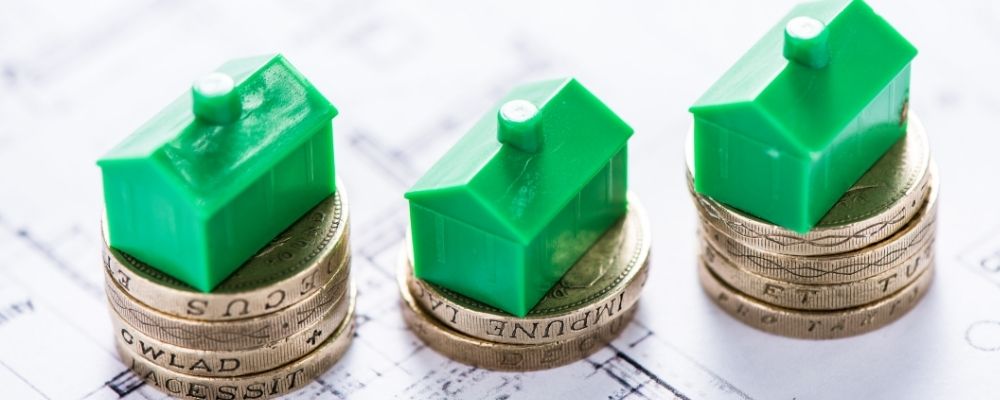One of the biggest challenges of being a landlord is knowing how to price rental property. If you charge too much for rent, then you won’t be able to fill any units, but if you price them too low, you may not be able to cover your basic expenses. Here is a look at how to price rental property so you get the best return on your investment.
What Determines Rent Prices?

Several factors will impact how much you charge for rent, including the monthly or yearly costs to maintain the property, the local supply and demand, and national or regional laws that impact landlords. Here are a few of the most important factors you should analyze when decided on how to price rental property.
1. Property Value
A good rule of thumb is to charge around 1% of your property value as rent. So, if the home is valued at $250,000, you should charge somewhere in the ballpark of $2500 per month to rent it to a tenant. This will allow you to determine a rough price that’s in line with the rest of the market.
Also, pay attention to what other landlords in the area are charging – this will let you know how to adjust your price to meet the local supply and demand. If it’s a hot rental market, you may be able to get away with charging closer to 2%, especially if your home has in-demand features like a pool or hot tub.
But if it’s not as hot and there is a lot of competition from other landlords who are offering good deals, you may want to stick closer to 0.8% of the overall property value. Hiring a broker to help you get an accurate valuation of the property and pull comps from similar homes in the area may also be a smart idea to help you determine a good price.
2. Local Laws
Another important thing to consider is any local laws that may impact how much you can charge for rent. Certain states have rent control laws that limit the amount you can charge in rent and how much you can increase that price each year.
Not all states have these laws, but several do include California, Maryland, New Jersey, New York, Washington DC, and Oregon. If you live in one of these states, you should consult with a broker or attorney before renting your property to see if these laws will impact your bottom line.
3. Additional Costs
Before determining a final price, it’s important to factor in all your costs to be sure that you are charging enough to turn a profit. This includes expenses like the mortgage, taxes, and insurance, as well as maintenance. Maintenance includes both routine upkeep and keeping a cash reserve for any unexpected repairs. About 50% of your rental income should go toward repairs and improvements, so make sure you budget accordingly.
How to Price Rental Property
- Get an Appraisal: Before you decide on how much to charge for rent, you have to know how much your property is worth. If you purchased it recently, you may already have a figure in mind. But if you put some work into the property and want to know its true value, you may consider hiring an appraiser to verify it’s value, then use the 1% rule to calculate rent.
- Pull Comps from the Neighborhood: Next, you should pull some comps from other similar properties in the neighborhood to be sure that what you’re charging makes sense for the market. Pay close attention to other rental properties and find out how much they are charging in rent, to be sure that what you’re asking isn’t too low or too high. This will also give you a good sense of your competition, so you can decide what number will attract the most qualified tenants.
- Calculate Expenses: Before determining a rental price, you have to also take stock of your expenses and be sure that you charge enough to cover them and make a profit. If you paid cash for a property, you have a bit more leeway with what you charge than if you took out a mortgage. But you’ll still have to pay taxes, insurance, and maintenance. So, it’s important to take stock of these expenses and determine a rental price that will provide enough cash flow to cover them.
- Adjust for Amenities: You should also take stock of whether your property has any special amenities that may attract tenants and adjust your prices accordingly. For instance, if you’re the only home in the area with a swimming pool, you can likely get away with charging a bit more than other comparable properties that do not have any extra features.
- Account for Vacancies: Also keep in mind that it’s nearly impossible to keep the property rented 100% of the time, so you should account for any potential losses due to vacancies.
How Much Profit Should You Make on a Rental Property?

There’s no set rule for how much you have to make for a rental property to be a success – as long as it’s cash flow positive and you’re not losing money each month. It all depends on your goals as an investor and your experience in real estate.
There are a few important metrics you should calculate to determine whether your property is a smart investment, including:
- Cash Flow: How much money is left over each month after paying expenses?
- Cap Rate: The ratio of the property’s annual net operating income compared to the purchase price. This article explains how to calculate cap rate in greater detail.
- ROI: How much profit the rental has accumulated, compared to the amount of cash invested.
Calculating these metrics will help you determine the viability of an investment property. The most important thing to do is set your own profit goals as an investor and make sure your portfolio can meet those expectations. Perhaps you’re looking for huge returns or maybe you’re just looking for a few hundred dollars in cash flow each month to pad your pockets. How much profit you ultimately make will be dependent on how much risk you’re willing to take, which is why it’s important to determine your own investing goals before making a purchase.



